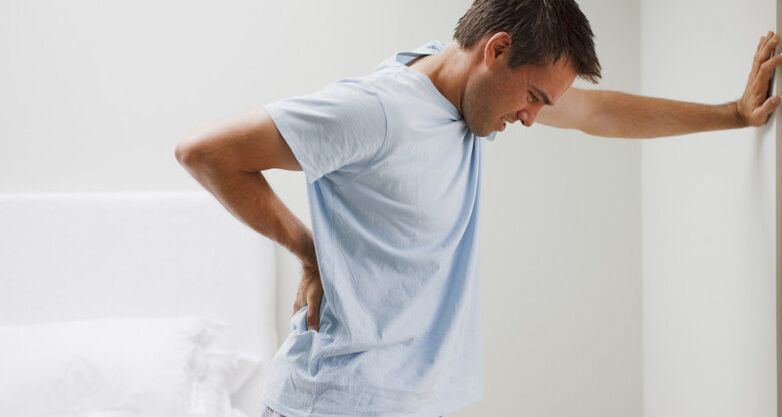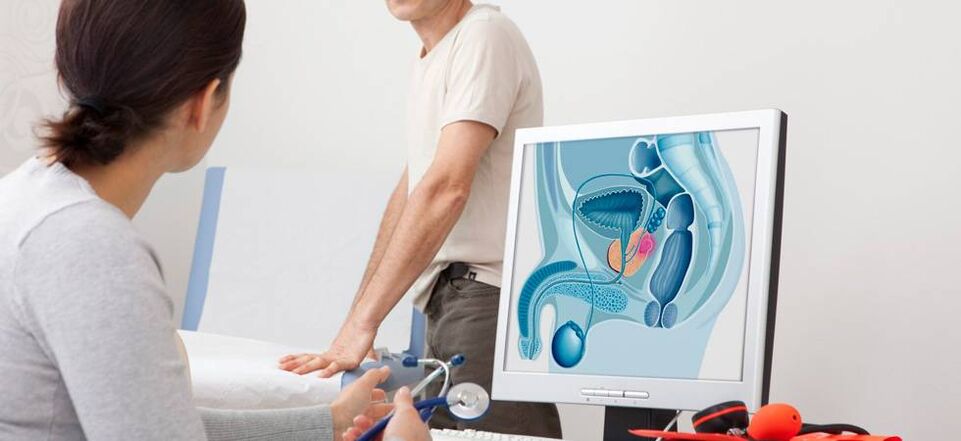The pathology of the prostate gland, which develops due to the inflammatory processes within it, is called a disease - prostatitis.
The development of pathology
More often than others, an infectious form of prostatitis occurs. The infection that is capable of impressing the prostate by penetrating the urethra hole or other organs and the glands of the geniturinary system.
The high probability of organ infection is due to the adjacent localization of the anus and the urethra channel.
This is likely to detect the inflammatory inflammation of the prostate in men, which is related to the fitness of the organ infected neighbors.
Even the presence of infection in the prostate does not ensure the development of inflammation.
Inflammation of the prostate occurs with the common effect of pathogenic microorganisms and provoking factors.
Causes of prostatitis
Every person, surprisingly or understanding, can figure out the course of prostatitis due to the worsening of provocative factors.
The prostate is the location of the urethral channel, so the inflammatory process, which leads to an increase in structure, leads to a violation of bladder emptying.
Binary nomenclature is used to diagnose different forms of inflammation of the prostate gland:
- Chronic non -infectious
- Chronic infectious
- Infectious
- Acute non -infectious
The types of prostatitis are due to a complex of provocative factors under certain circumstances.
The first factor that statistically dominates young and pre -egg men is infections of sexual partner.
Venus diseases, especially in the stage of symptomatic remission, in hidden or prostate lesions, are able to leave an infection that are progressive even after elimination of an infectious agent.
The infection can supplement the infection, systematic overdose, and the nutrition of acute, excessive oily, calorie carbohydrate foods.
This is how non -infectious prostatitis develops and improves the course of a non -infectious variety.
Provocation factors are hypothermia and age -related changes in the prostate.
Signs of prostatitis in men
It is difficult to diagnose the infectious or non -infectious form of prostate inflammation, only based on the similarity of the symptoms.
If the following signs of prostatitis are detected, the methods for detecting the disease should be comprehensive:
- When the bladder is evacuated, the pain and intensity can be experienced, and after the end of the urination, the patient feels a burning feeling in the urethra;
- Body temperature exceeds normal;
- Feeling of incomplete emptying of the bladder will not leave the sick man for a while after the end of urination;
- During the period between urination, pain is felt in perineum, inguinal and abdominal zones reflected in the legs, buttocks, pelvis and sacrum;
- lethargy and malaise.
One can suspect prostatitis if at least two are noticeable from the entire list and symptoms.
In the prostate, a specific sign of the inflammatory process is a temperature difference in different parts of the body.
The pattern of temperature changes is related to the localization of the focus of the inflammation: the closer it is, the higher the temperature.
When measuring the oral cavity temperature, no differences in the norm are observed in the armpit - at a subfebrile temperature, the parameter value in the rectum exceeds the norm than at a degree.
The symptom of pain develops as the intensity increases as the inflammation increases in the prostate.
The typical occurrence of pain is characterized by the process of bladder emptying, and the pain extends to the rectum and the entire area of the perineum throughout the day.
The intensity of pain increases with a small or unbearable impossibility.
Purder and malaise are dizziness and headache, little nausea attacks, drowsiness.
If such symptoms are observed, urine delay is suspected, as a result of which the body's general intoxication of the body develops protein products.
Durations of urination are associated with jet -powered slowness, long urine release, not to the imminent formation of the jet engine and to call for bladder emptying in the absence of urine emissions.
Potential complications
Post -prostatitis complications occur in the absence of medical intervention during the disease or inappropriate compilation of the treatment system.
Medical practice shows the most common distribution after prostatitis:
- lack of erection and ejaculation;
- the spread of the inflammatory process to the nearby organs of the curve system;
- Cytological disorders that lead to sperm inability to fertilize eggs;
- decrease in libido;
- Psychonurotic states that reduce the quality of life and health of the whole person.
After prostatitis, the penis sharply reduces the ability to harden and fill with blood. Possible sexual relationships will quickly end compared to recent complete sex life. Not all sexual relationships end with ejaculation.
If such differences are detected, a comprehensive diagnostic test is required.
As the inflammatory process spreads into the urethra and bladder, cystitis and uretritis develop.
With the development of the latter, sharp pain appears, and the process of damaged urine outflow (delay or incontinence) has become chronic. A person's performance in this state is doubtful.
Erectile dysfunction leaves many psychological and therapeutic problems that require a competent medical correction.
The impossibility of filling cave bodies with blood is explained by the edema state of the prostate and the associated genitourinary organs.
Blood supply to the penis, which is needed for a dry condition, becomes problematic.
From a psychological point of view, the third part of men developed by post -prostatitis consequences suffers in severe form.
Human condition can only normalize against the background of drug treatment during the long -term psychological work with the patient. The failures of sex life hinder the further desire to continue sex life.
Prostatitis can trigger a violation of sperm acid base composition, which reflects the sperm fertilization.
The result of pathology is the first degree man infertility. It is important in this state to eliminate the cause of the infertility in time, as there is no possibility to cure the infertility of the second stage by medication. The andrologist or urologist can prescribe appropriate treatment. This is the reason why men cannot ignore signs of prostatitis.
Diagnosis
The diagnostic test system is directly dependent on the complaints and signs the patient deals with the urologist or andrologist.
Diagnosis of prostatitis in men can be done both at home and in medical institutions.
The initial diagnostic phase is the collection of anamnesis. The physician performs external control of the genitals and listens to the patient's complaints.
Based on initial data, a sick person's further diagnostic examination scheme is set.
When collecting anamnesis, the physician learns the duration of the symptoms that appear, the presence of previously detected prostatitis, the list of patients' illnesses, the risk factors of the disease, the possible list of spread sexually transmitted diseases, the development of signs of the disease, the presence of sexual partners and the presence of sexual partners.
During the current phase of the development of medicine, the list of questions is published in the questionnaire, which the patient completed before the visit to the medical office. Thus, the patient and the doctor's time are rescued.
The first mandatory stage of a patient with signs of prostatitis is the study of the rectal gland.
The doctor determines the degree of growth of the inflamed organ, its density, the uniformity of the consistency or the presence of nodes or seals, and the degree of pain during palpation.
Before palpation, the intestinal cavity is performed.
In the absence of an inflammatory process in the prostate, there is no pain, in the case of prostatitis, the intensity of the pain may be different, and their localization can be felt in the lumbar, rectum, perineum and sacrum. In this case, many procedures, such as cystography, are contraindicated.
For microscopic examination of prostate secretion, the patient is performed through the rectum with massage of the prostate.
By the end of the prostate massage, this can only be done until prostate secretion from the urethra opening is analyzed.
The procedure ends by conducting the microscope's substrate along the urethra hole, followed by the smear painting and microscopic analysis according to the following parameters:
- the presence of leukocytes and calculation of their quantity;
- amount of lecithin;
- The activity and presence of pathogenic microorganisms.

Detection of bacteria at the anointing area of the smear indicates infectious types of prostatitis.
The number of leukocytes indicates the inflammatory process of the prostate in the field of vision more than 2.
For the reliable result of the microscopic examination, the fence should be correctly performed for the analysis and the medicine is competently painted.
The above tests are mandatory, and the doctor prescribes further examinations, depending on suspicion of the doctor.
The secret of the urethra is analyzed by a device similar to the catheter. At the top of the metal coating, cotton wool was injured.
Before the analysis is transferred, the urine is excluded for 2-3 hours. Otherwise, the microflor was washed into the external environment.
The doctor introduces a cotton tampon of about 4 cm in the hole of the penis and performs rotation movements. The urethral smear is tested for the presence of DNA and bacterial residues.
Analysis of urine is a means of detecting blood cells: red blood cells and leukocytes, protein (usually missing or immediately present).
When prescribing errors in the analysis of the urethra and prostatitis symptoms, the urinary tract required for bacteriological analysis is prescribed.
The disadvantage of the method is the long -term expectation of the colony of pathogenic microorganisms (up to 1 week).
Sowing is done by comparative method after three parts of the urine (the beginning, center and end of bladder emptying).
In one sample, a greater number of pathogenic microorganisms are based on assuming localization of infection focus.
Detection of the first part of the urine of bacteria does not give causes to strengthen inflammation.
The second and third parts of the urine, with the exceeding the number of microorganisms detected, provide a basis for clarifying the localization of inflammation (in the urethra and bladder).
The extent of sexual function is controlled by the norm by analyzing sperm by viscosity and other physico-chemical indicators of the environment, male gametes activity and viability, and spermograms are rarely prescribed.
The urofloometric method is not often resolved. If the possibility and addition of the changes in the changes occurred, the urinary uodynamic examination is performed.
An ultrasound examination determines the density of the patient organ and the density of other parameters, which is obtained after the prostate's finger examination.
The prostate can be seen in two ways: transreectal ultrasound and ultrasound through the abdominal cavity.
In case of suspicion of adenoma and prostate cancer, the doctor may prescribe an additional cytoscopic examination, a dog test called SO.
The fence is made from vein, a blood test determines (excludes) the presence of RSA protein, which appears with malignant tumors.
At home, the patient may suspect prostatitis, focusing on the color and confusion of the urine and the symptoms of the disease.
How to treat at home
Pharmaceutical
If signs of prostatitis appear, men should not walk on their own, medicines are prescribed only by a doctor.
The products recommended for healing prostatitis are distinguished by various forms and pharmaceutical properties. More often than others, candles are prescribed for rectal use.
The reason for the choice of doctors is the proximity of the components of the rectal suppositories and the prostate gland.
The actual effect of the active substance on the organ tissue on the organ tissue is the patient's peace in a situation, for 30 minutes after the rectal medicine is administered. Candles inactivate the pathogenic microflora and have an analgesic effect.
Intramuscular and intravenous injections contribute to the fastest effect of the patient's organ through the spread of bloodstream.
Immediately after urination, the installations are prescribed to penetrate the urethra into the medicinal substances through a hole in the prostate. The maximum amount of administration is 5 ml.
The desktop forms of prostatitis are better known than antibiotics that divide into 3 groups and successfully cope with the potential spectrum type of pathogenic microflora:
- Tetracycline
- Fluoroquinolons
- Penicillins
The imported materials are carried out in the evening.
The main prerequisite for using the enema is the unacceptability of the glandular strain and the temperature system. It refers to folk methods of treating prostatitis.


























